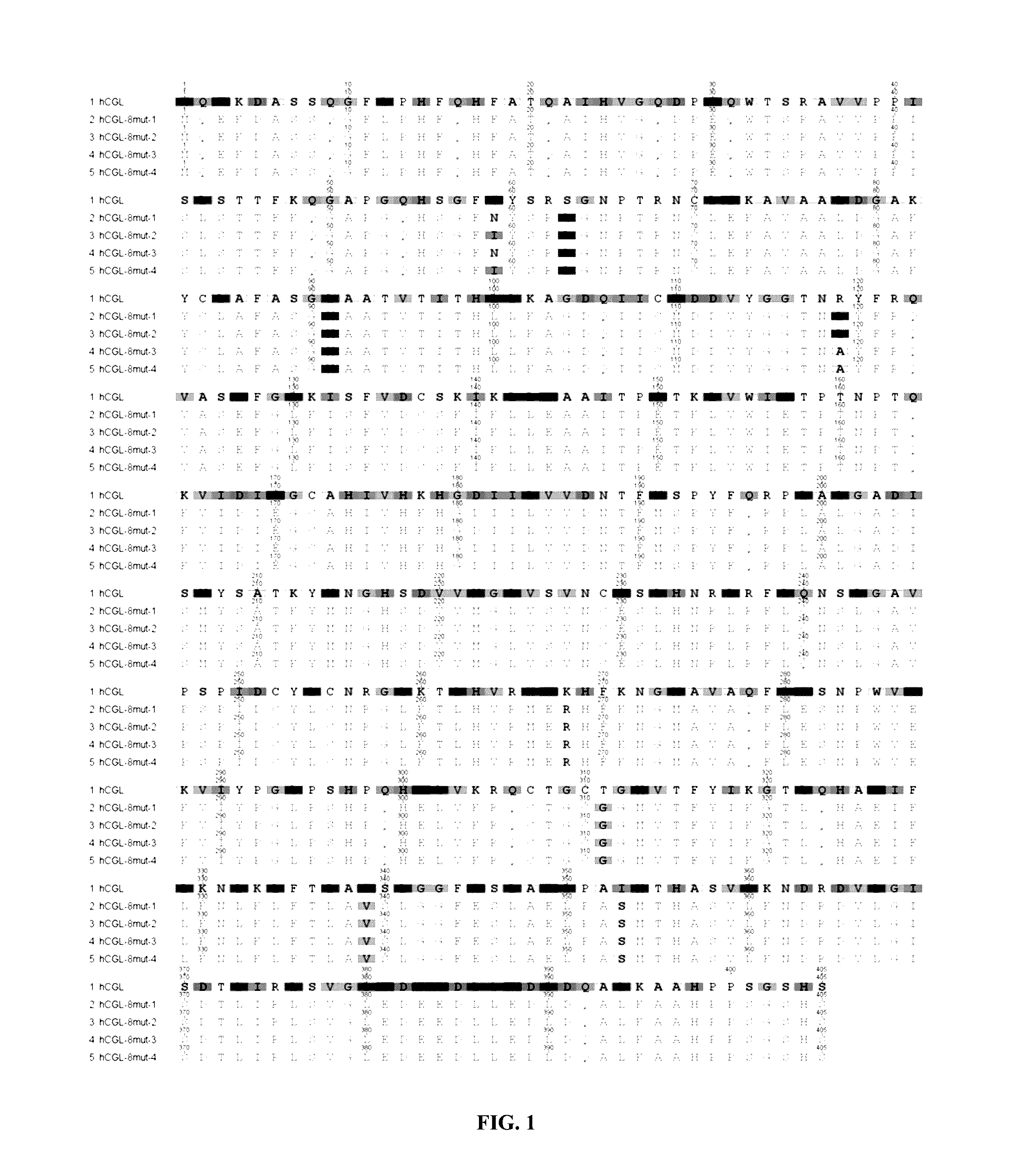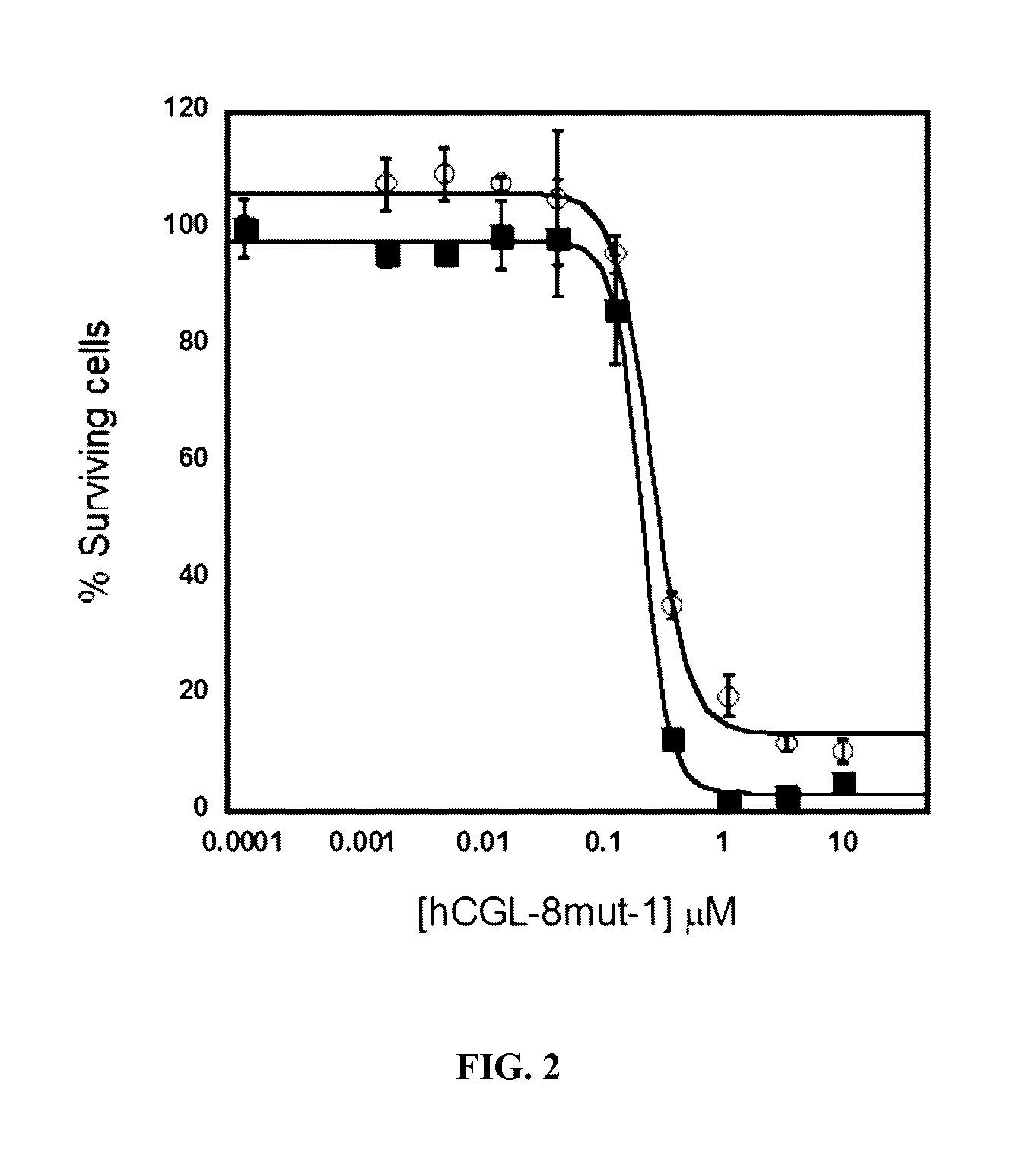Engineered primate L-methioninase for therapeutic purposes
a technology of l-methionine and primate, applied in the field of medicine and biology, can solve the problems of reduced activity, adverse reactions, and short half-life of methionine--lyase, and achieve the effect of increasing serum stability and increasing the in vivo half-li
- Summary
- Abstract
- Description
- Claims
- Application Information
AI Technical Summary
Benefits of technology
Problems solved by technology
Method used
Image
Examples
example 1
Cystathionine-γ-Lyase Engineered for Methionine-γ-Lyase Activity
[0187]CGL is a tetramer that catalyzes the last step in the mammalian transsulfuration pathway (Rao et al., 1990). CGL catalyzes the conversion of L-cystathionine to L-cysteine, alpha-ketobutyrate, and ammonia. The human CGL (hCGL) cDNA has previously been cloned and expressed, but with relatively low yields (˜5 mg / L culture) (Lu et al., 1992; Steegborn et al., 1999). Using sequence and structural alignments of CGL and MGL enzymes as a guide, hCGL was converted to an enzyme for the efficient degradation of methionine.
example 2
Gene Synthesis and Expression of Improved Modified Human Cystathionine-γ-Lyase
[0188]The human cystathionine-γ-lyase gene contains multiple codons that are rarely utilized in E. coli and can interfere with expression. Thus, in order to optimize protein expression in E. coli, the respective genes were assembled with codon optimized oligonucleotides designed using DNA-Works software (Hoover et al., 2002). Each construct contains an N-terminal NcoI restriction site, an in-frame N-terminal His6 tag, and a C-terminal EcoRI site for simplifying cloning. After cloning into a pET28a vector (Novagen), E. coli (BL21) containing an appropriate cystathionase expression vector were grown at 37° C. using Terrific Broth (TB) media containing 50 μg / mL kanamycin in shaker flasks at 250 rpm until reaching an OD600 of ˜0.5-0.6. At this point the cultures were switched to a shaker at 25° C., induced with 0.5 mM IPTG, and allowed to express protein for an additional 12 h. Cell pellets were then collected...
example 3
96-Well Plate Screen for Methionine-γ-Lyase Activity and Ranking Clones
[0189]Both MGL and CGL produce 2-ketobutanoic acid from their respective substrates. A colorimetric assay for the detection of α-keto acids using 3-methylbenzothiazolin-2-one hydrazone (MBTH) (Takakura et al., 2004) was scaled to a 96-well plate format for screening small libraries and for ranking clones with the greatest METase (methionine-γ-lyase) activity. This plate screen provides a facile method for picking the most active clones from the mutagenic libraries. Clones displaying greater activity than parental controls are selected for further characterization, thus eliminating the need to purify more than a few variants for kinetic analysis.
[0190]Single colonies containing mutagenized hCGL, hCGL or pMGL were picked into 96-well culture plates containing 75 μL of TB media / well containing 50 μg / mL kanamycin. These cultures were then grown at 37° C. on a plate shaker until reaching an OD600 of ˜0.8-1. After cool...
PUM
| Property | Measurement | Unit |
|---|---|---|
| molecular weight | aaaaa | aaaaa |
| pH | aaaaa | aaaaa |
| time | aaaaa | aaaaa |
Abstract
Description
Claims
Application Information
 Login to View More
Login to View More - R&D
- Intellectual Property
- Life Sciences
- Materials
- Tech Scout
- Unparalleled Data Quality
- Higher Quality Content
- 60% Fewer Hallucinations
Browse by: Latest US Patents, China's latest patents, Technical Efficacy Thesaurus, Application Domain, Technology Topic, Popular Technical Reports.
© 2025 PatSnap. All rights reserved.Legal|Privacy policy|Modern Slavery Act Transparency Statement|Sitemap|About US| Contact US: help@patsnap.com



